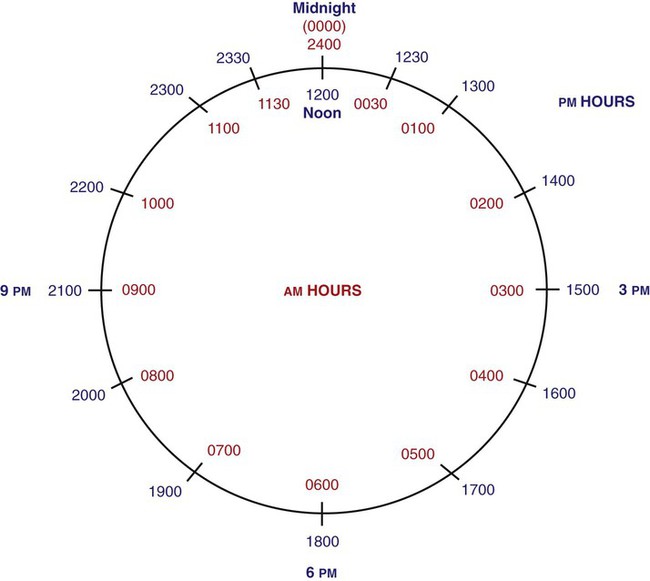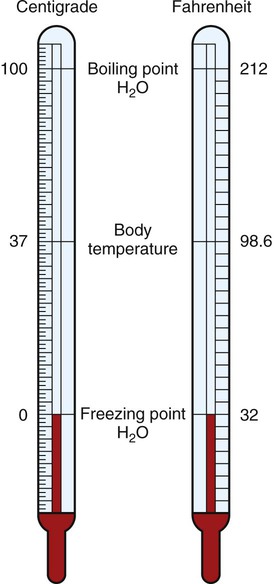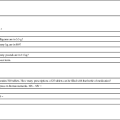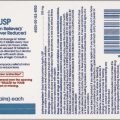Conversion of Clinical Measurements of Numbers, Time, and Temperature
• Express Arabic numbers in Roman numerals
• Express Roman numerals in Arabic numbers
• Convert time between standard time and military (or universal) time
Arabic Numbers And Roman Numerals
Roman Numeral Use
The rules for using Roman numerals are as follows:
• When a numeral is repeated, the value of the number is the number of times for the repetition to provide the needed number (e.g., III = 3).
• A numeral may be repeated up to three times in succession and no more (e.g., IIII as 4 is incorrect; the correct way to express 4 is IV).
• The letters V, L, and D are not repeated (e.g., VV is incorrect for 10).
• When a numeral of lower value is placed following a larger numeral value, the smaller numeral is added to the larger numeral (e.g., XI = 11, VI = 6). Only I, X, or C can be used in this manner.
• If the smaller numeral value is placed before the larger numeral value, the smaller value is subtracted from the larger numeral value (e.g., IV = 5 − 1, or 4). Again, only I, X, or C may be used in this manner.
• Only one smaller number may be placed either before a larger number (e.g., IIX is not 8; rather, 8 is expressed as VIII).
• The subtracted number must be no less than one tenth of the value of the number from which it is subtracted (e.g., X may be placed before a C or an L but cannot be used with M or D. Thus 49 must be stated as XLIX rather than IL).
• Use the largest value numerals possible (e.g., 15 is XV, not VVV or XIIIII).
• Use I before V and X (the next two higher numerals). The numeral X may be used before L and C (the next higher numerals). Although seldom used, C may be used before D and M.
•  is used as an abbreviation for one-half.
is used as an abbreviation for one-half.
• Medical notations of Roman numerals are usually written in the lower case with a line drawn over the numerals to prevent misinterpretation. The lowercase “i” has the line usually with the dot above the line, not below as commonly written.
Conversion Between 12-Hour And Universal (Military Or 24-Hour) Time
In universal time, all time is expressed in four-digit numbers beginning at 1 minute past midnight, or 0001 hours. The time is stated in hundreds of hours with 1 am being 0100 hours and said as “zero one-hundred hours.” Ten in the morning is the first time that a double digit precedes the hour with 10 o’clock being said as “ten hundred hours.” Noon is 1200 hours and said as “twelve hundred hours.” One o’clock in the afternoon becomes 1300 hours, or “thirteen hundred hours.” Midnight then becomes 2400, or “twenty-four hundred hours,” or at some sites it is read as 0000, or “zero hundred hours.” Figure 3-1 shows an example of a military time clock. The am (ante meridian, or before noon) readings are found on the inside of the clock face, whereas the pm (post meridian, or after noon) readings are found on the outside of the clock face.

Conversion Between Fahrenheit And Celsius Temperature
In the United States, Fahrenheit temperature (F) is the measurement most commonly used. In countries where the metric system is used, Celsius (C) or centigrade temperature measurement is the most commonly used scale. In the Fahrenheit scale, water boils at 212°, whereas in Celsius water boils at 100°. Likewise, the freezing points are not the same; Fahrenheit is 32°, whereas Celsius is 0°. Figure 3-2 provides a comparison of the scales. As you can quickly see, the Fahrenheit scale has 180° between the freezing and boiling points, whereas the Celsius scale contains only 100°. The formulas for conversion between the two scales have been developed with these differences as the basis. The conversion equations are shown below.
Review of Rules
Roman Numerals and Arabic Numerals
• When a Roman numeral is repeated, the value of the number is the number of times of repetition. The numeral may be repeated up to three times.
• The letters V, L, and D are not repeated.
• When a numeral of a lower value is placed following a larger numeral value, the value of the smaller numeral is added to the larger numeral.
• If a numeral of a lower value is placed before a larger numeral, the value of the smaller numeral is subtracted from the larger numeral. Only one smaller numeral may be placed in front of a larger numeral to indicate the decrease in the larger numeral.
• The numeral subtracted from a larger numeral can be no less than one tenth of the value of the number from which it is subtracted.
Military Time and 12-Hour Time
• Military and traditional time have the same meaning from 1 am to 12:59 pm.
• Minutes after midnight may be written either as 0000 or 2400 hours depending on the policy of the employment site.
• Minutes after midnight and before 1:00 am are written with 00 followed by the number of minutes.
• The hours between 1 pm and 12 am are the time plus 12 added to the hour.
• If time requires seconds, the military time will include 6 numerals. Add two digits to the right of the minutes.

 ________
________ ________
________ ________
________ ________
________ ________
________ ________
________ ________
________ as fractional numbers, or 0.53 as a decimal number.
as fractional numbers, or 0.53 as a decimal number. = 1/2
= 1/2 = 1
= 1 = 5
= 5 = 10
= 10 __________
__________ __________
__________ __________
__________ __________
__________ __________
__________ is the same as
is the same as  . Change
. Change  into an Arabic number by first dividing the Roman numeral into separate parts. Thus
into an Arabic number by first dividing the Roman numeral into separate parts. Thus  is xix, or 10 (x) + 9 (ix) (10 − 1) +
is xix, or 10 (x) + 9 (ix) (10 − 1) +  (
( ), or
), or  . To change an Arabic number to a Roman numeral,
. To change an Arabic number to a Roman numeral,  would be x (10) + v (5) + i (1) +
would be x (10) + v (5) + i (1) +  (
( ), or
), or 
 __________
__________ __________
__________ __________
__________ __________
__________ __________
__________ __________
__________ __________
__________ __________
__________
 . Another way of looking at it is that the Celsius degree is 1.8 Fahrenheit degrees after the difference of 32° has been subtracted from the Fahrenheit temperature. If we want the number of Celsius degrees in the Fahrenheit scale, the Celsius scale would be that
. Another way of looking at it is that the Celsius degree is 1.8 Fahrenheit degrees after the difference of 32° has been subtracted from the Fahrenheit temperature. If we want the number of Celsius degrees in the Fahrenheit scale, the Celsius scale would be that  , or
, or  of the Celsius degree is found in one Fahrenheit degree. So the following conversion formulas may be used to change from one temperature scale to the other.
of the Celsius degree is found in one Fahrenheit degree. So the following conversion formulas may be used to change from one temperature scale to the other.




 + 32, the formula would look like the following:
+ 32, the formula would look like the following:











 __________
__________ __________
__________ __________
__________ __________
__________ to be dispensed as a tablet dose. How many grains of medication will be given as the dose? __________
to be dispensed as a tablet dose. How many grains of medication will be given as the dose? __________ or C° = (F° − 32) ×
or C° = (F° − 32) × 



